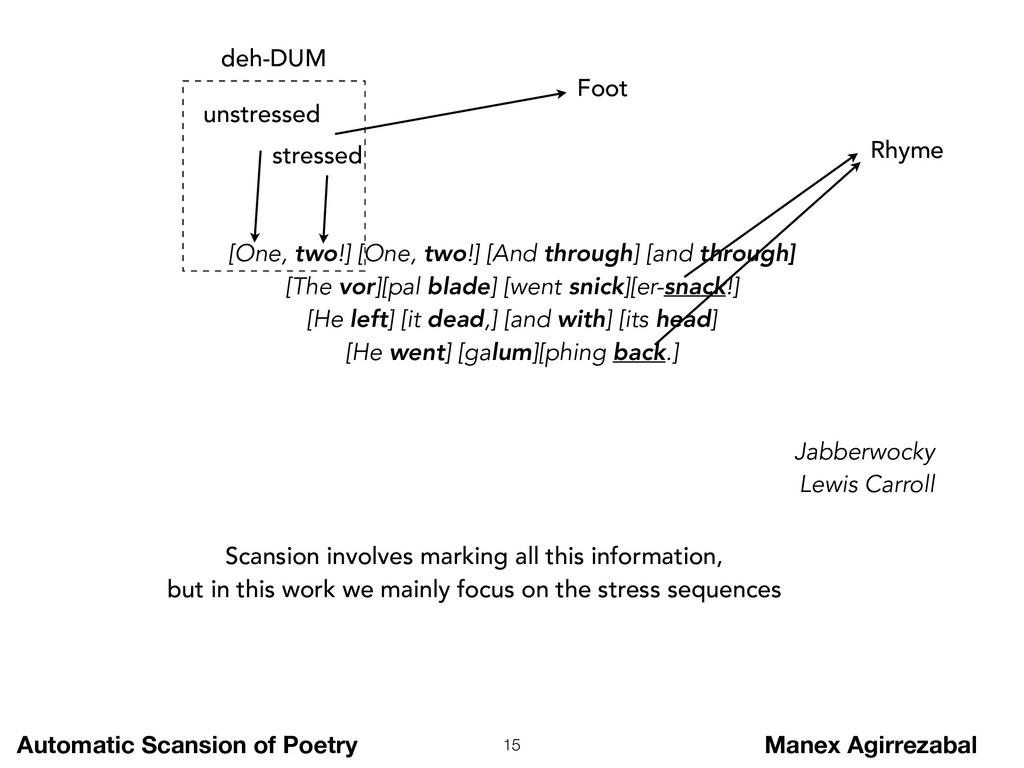

Margaret Robertson, editor (2007), Poems published in 1820 by John Keats, Project Gutenberg. Plamondon (2006), Virtual verse analysis: analysing patterns in poetry, Literary and Linguistic Computing, 21 (1): 127-141. Josef Novak, Nobuaki Minematsu, and Keikichi Hirose (2012), WFST-based grapheme-to-phoneme conversion: open source tools for alignment, model-building and decoding, in Proceedings of the 10th Internaltional Workshop on Finite-State Methods and Natural Language Processing, pp. Murray (1925), Homer: The Iliad, Heinemann.

Harriet Monroe (1917), The new poetry: an anthology, The Macmillan Company. McAleese (2007), Improving scansion with syntax: an investigation into the effectiveness of a syntactic analysis of poetry by computer using phonological scansion theory, Technical report, Department of Computing Faculty of Mathematics, Computing and Technology The Open University. Marcus, Mary Ann Marcinkiewicz, and Beatrice Santorini (1993), Building a large annotated corpus of English: the Penn Treebank, Computational Linguistics, 19 (2): 313-330. Longfellow (1855), The Song of Hiawatha, David Bogue. Logan (1988), Computer analysis of sound and meter in poetry, College Literature, 15 (1): 19-24. Mans Hulden (2009), Foma: a finite-state compiler and library, in Proceedings of the 12th Conference of the European Chapter of the Association for Computational Linguistics (Demonstrations Session), pp. Mans Hulden (2006), Finite-state syllabification, in Anssi Yli-Jyrä, Lauri Karttunen, and Juhani Karhumäki, editors, Finite-State Methods and Natural Language Processing, volume 4002 of Lecture Notes in Computer Science, pp. Hartman (1996), Virtual muse: experiments in computer poetry, Wesleyan University Press. Morris Halle and Jean-Roger Vergnaud (1987), An essay on stress, MIT Press. Péter Halácsy, András Kornai, and Csaba Oravecz (2007), HunPos: an open source trigram tagger, in Proceedings of the 45th Annual Meeting of the Association for Computational Linguistics (Interactive Poster and Demonstration Sessions), pp. Groves (1998), Strange music: the metre of the English heroic line, volume 74 of ELS Monograph Series, English Literary Studies, University of Victoria. Erica Greene, Tugba Bodrumlu, and Kevin Knight (2010), Automatic analysis of rhythmic poetry with applications to generation and translation, in Proceedings of the 2010 Conference on Empirical Methods in Natural Language Processing, pp. Natalie Gerber (2013), Stress-based metrics revisited: a comparative exercise in scansion systems and their implications for iambic pentameter, Thinking Verse, III: 131-168. Paul Fussell (1965), Poetic meter and poetic form, McGraw Hill. Robert Frost (1979), The poetry of Robert Frost: the collected poems, complete and unabridged, Henry Holt and Company.
#Scansion poems software#
Rong-En Fan, Kai-Wei Chang, Cho-Jui Hsieh, Xiang-Rui Wang, and Chih-Jen Lin (2008), LIBLINEAR: A library for large linear classification, The Journal of Machine Learning Research, 9:1871-1874, software available at.
#Scansion poems manual#
Alfred Corn (1997), The poem’s heartbeat: a manual of prosody, Copper Canyon Press.

Noam Chomsky and Morris Halle (1968), The sound pattern of English, Harper & Row.

Chih-Chung Chang and Chih-Jen Lin (2011), LIBSVM: A library for suport vector machines, ACM Transactions on Intelligent Systems and Technology, 2:27:1-27:27, software available AT. Lewis Carroll (1916), Alice’s Adventures in Wonderland and Through the Looking Glass, George W. Lewis Carroll (1869), Phantasmagoria and Other Poems, London: Macmillan. Brogan (1981), English versification, 1570-1980: a reference guide with a global appendix, Johns Hopkins University Press. Beesley and Lauri Karttunen (2003), Finite-state morphology: Xerox tools and techniques, CSLI. Manex Agirrezabal, Jeffrey Heinz, Mans Hulden, and Bertol Arrieta (2014), Assigning stress to out-of-vocabulary words: three approaches, International Conference on Artificial Intelligence, 27: 105-110. Manex Agirrezabal, Bertol Arrieta, Aitzol Astigarraga, and Mans Hulden (2013), POS-tag based poetry generation with WordNet, Proceedings of the 2013 European Workshop on Natural Language Generation, pp.


 0 kommentar(er)
0 kommentar(er)
